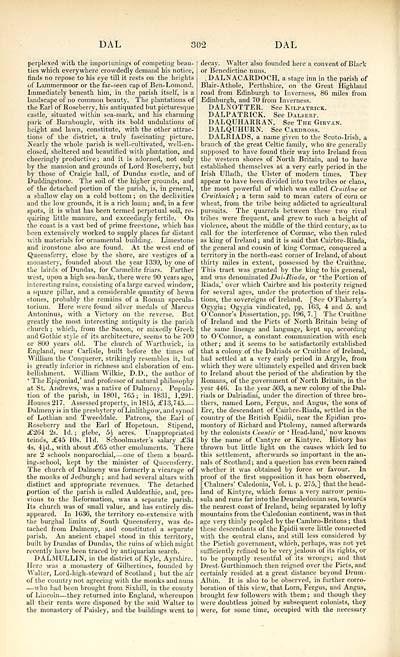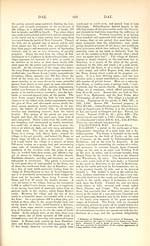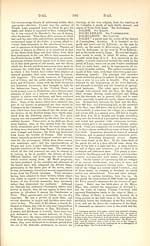Topographical, statistical, and historical gazetteer of Scotland > Volume 1
(384) Page 302 - DAL
Download files
Complete book:
Individual page:
Thumbnail gallery: Grid view | List view

DAL
302
DAL
perplexed with the importunings of competing beau-
ties which everywhere crowdedly demand his notice,
rinds no repose to his eye till it rests on the heights
of Lammermoor or the far-seen cap of Ben-Lomond.
Immediately beneath him, in the parish itself, is a
landscape of no common beauty. The plantations of
the Earl of Roseberry, his antiquated but picturesque
castle, situated witliin sea-mark, and his charming
park of Barnbougle, with its bold undulations of
height and lawn, constitute, with the other attrac-
tions of the district, a truly fascinating picture.
Nearly the whole parish is well-cultivated, well-en-
closed, sheltered and beautified with plantation, and
cheeringly productive ; and it is adorned, not only
by the mansion and grounds of Lord Roseberry, but
by those of Craigie hall, of Dundas castle, and of
Duddingstone. The soil of the higher grounds, and
of the detached portion of tbe parish, is, in general,
a shallow clay on a cold bottom ; on the declivities
and the low grounds, it is a rich loam; and, in a few
spots, it is what has been termed perpetual soil, re-
quiring little manure, and exceedingly fertile. On
the coast is a vast bed of prime freestone, which has
been extensively worked to supply places far distant
with materials for ornamental building. Limestone
and ironstone also are found. At the west end of
Queensferry, close by the shore, are vestiges of a
monastery, founded about the year 1330, by one of
the lairds of Dundas, for Carmelite friars. Farther
west, upon a high sea-bank, there were 90 years ago,
interesting ruins, consisting of a large carved window,
a square pillar, and a considerable quantity of hewn
stones, probably the remains of a Roman specula-
torium. Here were found silver medals of Marcus
Antoninus, with a Victory on the reverse. But
greatly the most interesting antiquity is the parish
church ; which, from the Saxon, or mixedly Greek
and Gothic style of its architecture, seems to be 700
or 800 years old. The church of Warthwick, in
England, near Carlisle, built before the times of
William the Conquerer, strikingly resembles it, but
is greatly inferior in richness and elaboration of em-
bellishment. William Wilkie, D.D., the author of
' The Epigoniad,' and professor of natural philosophy
at St. Andrews, was a native of Dalmeny. Popula-
tion of the parish, in 1801, 765; in 1831, 1,291.
Houses 217. Assessed property, in 1815, .£13,745
Dalmeny is in the presbytery of Linlithgow, and synod
of Lothian and Tweeddale. Patrons, the Earl of
Roseberry and the Earl of Hopetoun. Stipend,
£264 2s. Id. ; glebe, 5i acres. Unappropriated
teinds, £45 10s. lid. Schoolmaster's salary £34
4s. 4£d., with about £65 other emoluments. There
are 2 schools nonparochial, — one of them a board-
ing-school, kept by the minister of Queensferry.
The church of Dalmeny was formerly a vicarage of
the monks of Jedburgh ; and had several altars with
distinct and appropriate revenues. The detached
portion of the parish is called Auldcathie, and, pre-
vious to the Reformation, was a separate parish.
Its church was of small value, and has entirely dis-
appeared. In 1636, the territory co-extensive with
the burghal limits of South Queensferry, was de-
tached from Dalmeny, and constituted a separate
parish. An ancient chapel stood in this territory,
built by Dundas of Dundas, the ruins of which might
recently have been traced by antiquarian search.
DALMULLIN, in the district of Kyle, Ayrshire.
Here was a monastery of Gilbertines, founded by
Walter, Lord-high-steward of Scotland ; but the air
of the country not agreeing with the monks and nuns
— who had been brought from Sixhill, in the county
of Lincoln — they returned into England, whereupon
all their rents were disponed by the said Walter to
the monastery of Paisley, and the buildings went to
decay. Walter also founded here a convent of Black
or Benedictine nuns.
DALNACARDOCH, a stage inn in the parish of
Blair- Athole, Perthshire, on the Great Highland
road from Edinburgh to Inverness, 86 miles from
Edinburgh, and 70 from Inverness.
DALNOTTER. See Kilpatrick.
DALPATRICK. See Dalserp.
DALQUHARRAN. See The Girvan.
DALQUHURN. See Cardross.
DALRIADS, a name given to the Scoto-Irish, a
branch of the great Celtic family, who are generally
supposed to have found their way into Ireland from
the western shores of North Britain, and to have
established themselves at a very early period in the
Irish Ulladh, the Ulster of modern times. They
appear to have been divided into two tribes or clans,
the most powerful of which was called Cruithne or
Cruithnich ; a term said to mean eaters of corn or
wheat, from the tribe being addicted to agricultural
pursuits. The quarrels between these two rival
tribes were frequent, and grew to such a height of
violence, about the middle of the third century, as to
call for the interference of Cormac, who then ruled
as king of Ireland ; and it is said that Cairbre-Riada,
the general and cousin of king Cormac, conquered a
territory in the north-east corner of Ireland, of about
thirty miles in extent, possessed by the Cruithne.
This tract was granted by the king to his general,
and was denominated Dal-Riada, or 'the Portion of
Riada,' over which Cairbre and his posterity reigned
for several ages, under the protection of their rela-
tions, the sovereigns of Ireland. [See O'Flaherty's
Ogygia; Ogygia vindicated, pp. 163, 4 and 5. and
O'Connor's Dissertation, pp. 196, 7.] The Cruithne
of Ireland and the Picts of North Britain being of
the same lineage and language, kept up, according
to O'Connor, a constant communication with each
other ; and it seems to be satisfactorily established
that a colony of the Dalriads or Cruithne of Ireland,
had settled at a very early period in Argyle, from
which they were ultimately expelled and driven back
to Ireland about the period of the abdication by the
Romans, of the government of North Britain, in the
year 446. In the year 503, a new colony of the Dal-
riads or Dalriadini, under the direction of three bro-
thers, named Lorn, Fergus, and Angus, the sons of
Ere, the descendant of Cairbre-Riada, settled in the
country of the British Epidii, near the Epidian pro-
montory of Richard and Ptolemy, named afterwards
by the colonists Ceantir or ' Head-land,' now known
by the name of Cantyre or Kintyre. History has
thrown but little light on the causes which led to
this settlement, afterwards so important in the an-
nals of Scotland ; and a question has even been raised
whether it was obtained by force or favour. In
proof of the first supposition it has been observed,
[Chalmers' Caledonia, Vol. i. p. 275,] that the head-
land of Kintyre, which forms a very narrow penin-
sula and runs far into the Deucaledonian sea, towards
the nearest coast of Ireland, being separated by lofty
mountains from the Caledonian continent, was in that
age very thinly peopled by the Cambro-Britons ; that
these descendants of the Epidii were little connected
with the central clans, and still less considered by
the Pictish government, which, perhaps, was not yet
sufficiently refined to be very jealous of its rights, or
to be promptly resentful of its wrongs; and that
Drest-Gurthinmoeh then reigned over the Picts, and
certainly resided at a great distance beyond Drum;
Albin. It is also to be observed, in further corro-
boration of this view, that Lorn, Fergus, and Angus,
brought few followers with them ; and though they
were doubtless joined by subsequent colonists, they
were, for some time, occupied with the necessary
302
DAL
perplexed with the importunings of competing beau-
ties which everywhere crowdedly demand his notice,
rinds no repose to his eye till it rests on the heights
of Lammermoor or the far-seen cap of Ben-Lomond.
Immediately beneath him, in the parish itself, is a
landscape of no common beauty. The plantations of
the Earl of Roseberry, his antiquated but picturesque
castle, situated witliin sea-mark, and his charming
park of Barnbougle, with its bold undulations of
height and lawn, constitute, with the other attrac-
tions of the district, a truly fascinating picture.
Nearly the whole parish is well-cultivated, well-en-
closed, sheltered and beautified with plantation, and
cheeringly productive ; and it is adorned, not only
by the mansion and grounds of Lord Roseberry, but
by those of Craigie hall, of Dundas castle, and of
Duddingstone. The soil of the higher grounds, and
of the detached portion of tbe parish, is, in general,
a shallow clay on a cold bottom ; on the declivities
and the low grounds, it is a rich loam; and, in a few
spots, it is what has been termed perpetual soil, re-
quiring little manure, and exceedingly fertile. On
the coast is a vast bed of prime freestone, which has
been extensively worked to supply places far distant
with materials for ornamental building. Limestone
and ironstone also are found. At the west end of
Queensferry, close by the shore, are vestiges of a
monastery, founded about the year 1330, by one of
the lairds of Dundas, for Carmelite friars. Farther
west, upon a high sea-bank, there were 90 years ago,
interesting ruins, consisting of a large carved window,
a square pillar, and a considerable quantity of hewn
stones, probably the remains of a Roman specula-
torium. Here were found silver medals of Marcus
Antoninus, with a Victory on the reverse. But
greatly the most interesting antiquity is the parish
church ; which, from the Saxon, or mixedly Greek
and Gothic style of its architecture, seems to be 700
or 800 years old. The church of Warthwick, in
England, near Carlisle, built before the times of
William the Conquerer, strikingly resembles it, but
is greatly inferior in richness and elaboration of em-
bellishment. William Wilkie, D.D., the author of
' The Epigoniad,' and professor of natural philosophy
at St. Andrews, was a native of Dalmeny. Popula-
tion of the parish, in 1801, 765; in 1831, 1,291.
Houses 217. Assessed property, in 1815, .£13,745
Dalmeny is in the presbytery of Linlithgow, and synod
of Lothian and Tweeddale. Patrons, the Earl of
Roseberry and the Earl of Hopetoun. Stipend,
£264 2s. Id. ; glebe, 5i acres. Unappropriated
teinds, £45 10s. lid. Schoolmaster's salary £34
4s. 4£d., with about £65 other emoluments. There
are 2 schools nonparochial, — one of them a board-
ing-school, kept by the minister of Queensferry.
The church of Dalmeny was formerly a vicarage of
the monks of Jedburgh ; and had several altars with
distinct and appropriate revenues. The detached
portion of the parish is called Auldcathie, and, pre-
vious to the Reformation, was a separate parish.
Its church was of small value, and has entirely dis-
appeared. In 1636, the territory co-extensive with
the burghal limits of South Queensferry, was de-
tached from Dalmeny, and constituted a separate
parish. An ancient chapel stood in this territory,
built by Dundas of Dundas, the ruins of which might
recently have been traced by antiquarian search.
DALMULLIN, in the district of Kyle, Ayrshire.
Here was a monastery of Gilbertines, founded by
Walter, Lord-high-steward of Scotland ; but the air
of the country not agreeing with the monks and nuns
— who had been brought from Sixhill, in the county
of Lincoln — they returned into England, whereupon
all their rents were disponed by the said Walter to
the monastery of Paisley, and the buildings went to
decay. Walter also founded here a convent of Black
or Benedictine nuns.
DALNACARDOCH, a stage inn in the parish of
Blair- Athole, Perthshire, on the Great Highland
road from Edinburgh to Inverness, 86 miles from
Edinburgh, and 70 from Inverness.
DALNOTTER. See Kilpatrick.
DALPATRICK. See Dalserp.
DALQUHARRAN. See The Girvan.
DALQUHURN. See Cardross.
DALRIADS, a name given to the Scoto-Irish, a
branch of the great Celtic family, who are generally
supposed to have found their way into Ireland from
the western shores of North Britain, and to have
established themselves at a very early period in the
Irish Ulladh, the Ulster of modern times. They
appear to have been divided into two tribes or clans,
the most powerful of which was called Cruithne or
Cruithnich ; a term said to mean eaters of corn or
wheat, from the tribe being addicted to agricultural
pursuits. The quarrels between these two rival
tribes were frequent, and grew to such a height of
violence, about the middle of the third century, as to
call for the interference of Cormac, who then ruled
as king of Ireland ; and it is said that Cairbre-Riada,
the general and cousin of king Cormac, conquered a
territory in the north-east corner of Ireland, of about
thirty miles in extent, possessed by the Cruithne.
This tract was granted by the king to his general,
and was denominated Dal-Riada, or 'the Portion of
Riada,' over which Cairbre and his posterity reigned
for several ages, under the protection of their rela-
tions, the sovereigns of Ireland. [See O'Flaherty's
Ogygia; Ogygia vindicated, pp. 163, 4 and 5. and
O'Connor's Dissertation, pp. 196, 7.] The Cruithne
of Ireland and the Picts of North Britain being of
the same lineage and language, kept up, according
to O'Connor, a constant communication with each
other ; and it seems to be satisfactorily established
that a colony of the Dalriads or Cruithne of Ireland,
had settled at a very early period in Argyle, from
which they were ultimately expelled and driven back
to Ireland about the period of the abdication by the
Romans, of the government of North Britain, in the
year 446. In the year 503, a new colony of the Dal-
riads or Dalriadini, under the direction of three bro-
thers, named Lorn, Fergus, and Angus, the sons of
Ere, the descendant of Cairbre-Riada, settled in the
country of the British Epidii, near the Epidian pro-
montory of Richard and Ptolemy, named afterwards
by the colonists Ceantir or ' Head-land,' now known
by the name of Cantyre or Kintyre. History has
thrown but little light on the causes which led to
this settlement, afterwards so important in the an-
nals of Scotland ; and a question has even been raised
whether it was obtained by force or favour. In
proof of the first supposition it has been observed,
[Chalmers' Caledonia, Vol. i. p. 275,] that the head-
land of Kintyre, which forms a very narrow penin-
sula and runs far into the Deucaledonian sea, towards
the nearest coast of Ireland, being separated by lofty
mountains from the Caledonian continent, was in that
age very thinly peopled by the Cambro-Britons ; that
these descendants of the Epidii were little connected
with the central clans, and still less considered by
the Pictish government, which, perhaps, was not yet
sufficiently refined to be very jealous of its rights, or
to be promptly resentful of its wrongs; and that
Drest-Gurthinmoeh then reigned over the Picts, and
certainly resided at a great distance beyond Drum;
Albin. It is also to be observed, in further corro-
boration of this view, that Lorn, Fergus, and Angus,
brought few followers with them ; and though they
were doubtless joined by subsequent colonists, they
were, for some time, occupied with the necessary
Set display mode to: Large image | Transcription
Images and transcriptions on this page, including medium image downloads, may be used under the Creative Commons Attribution 4.0 International Licence unless otherwise stated. ![]()
| Gazetteers of Scotland, 1803-1901 > Topographical, statistical, and historical gazetteer of Scotland > Volume 1 > (384) Page 302 - DAL |
|---|
| Permanent URL | https://digital.nls.uk/97442154 |
|---|
| Description | Volume first. A-H. |
|---|---|
| Attribution and copyright: |
|

